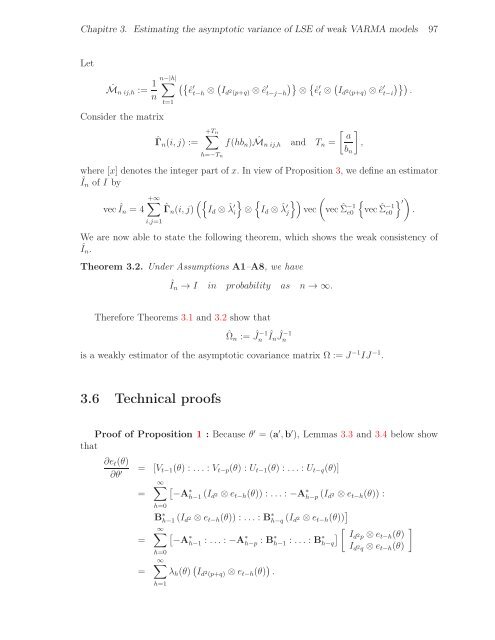THÈSE Estimation, validation et identification des modèles ARMA ...
THÈSE Estimation, validation et identification des modèles ARMA ...
THÈSE Estimation, validation et identification des modèles ARMA ...
Create successful ePaper yourself
Turn your PDF publications into a flip-book with our unique Google optimized e-Paper software.
Chapitre 3. Estimating the asymptotic variance of LSE of weak V<strong>ARMA</strong> models 97<br />
L<strong>et</strong><br />
ˆMn ij,h := 1<br />
n<br />
Consider the matrix<br />
n−|h| <br />
t=1<br />
ˆΓn(i,j) :=<br />
<br />
′<br />
ê t−h ⊗ Id2 (p+q) ⊗ê ′ <br />
′<br />
t−j−h ⊗ ê t ⊗ Id2 (p+q) ⊗ê ′ <br />
t−i .<br />
+Tn <br />
h=−Tn<br />
f(hbn) ˆ Mn ij,h and Tn =<br />
where [x] denotes the integer part of x. In view of Proposition 3, we define an estimator<br />
În of I by<br />
vec În = 4<br />
+∞<br />
i,j=1<br />
<br />
ˆΓn(i,j) Id ⊗ ˆ λ ′ <br />
i ⊗ Id ⊗ ˆ λ ′ <br />
j vec<br />
a<br />
bn<br />
vec ˆ Σ −1<br />
e0<br />
<br />
,<br />
<br />
vec ˆ Σ −1<br />
e0<br />
′ <br />
.<br />
We are now able to state the following theorem, which shows the weak consistency of<br />
În.<br />
Theorem 3.2. Under Assumptions A1–A8, we have<br />
În → I in probability as n → ∞.<br />
Therefore Theorems 3.1 and 3.2 show that<br />
ˆΩn := ˆ J −1<br />
n În ˆ J −1<br />
n<br />
is a weakly estimator of the asymptotic covariance matrix Ω := J −1 IJ −1 .<br />
3.6 Technical proofs<br />
Proof of Proposition 1 : Because θ ′ = (a ′ ,b ′ ), Lemmas 3.3 and 3.4 below show<br />
that<br />
∂<strong>et</strong>(θ)<br />
∂θ ′ = [Vt−1(θ) : ... : Vt−p(θ) : Ut−1(θ) : ... : Ut−q(θ)]<br />
∞<br />
=<br />
=<br />
=<br />
h=0<br />
−A ∗ h−1 (I d 2 ⊗<strong>et</strong>−h(θ)) : ... : −A ∗ h−p (I d 2 ⊗<strong>et</strong>−h(θ)) :<br />
B ∗ h−1(Id2 ⊗<strong>et</strong>−h(θ)) : ... : B ∗ <br />
2<br />
h−q(Id ⊗<strong>et</strong>−h(θ))<br />
∞ ∗<br />
−Ah−1 : ... : −A ∗ h−p : B ∗ h−1 : ... : B ∗ h−q<br />
h=0<br />
∞<br />
λh(θ) Id2 (p+q) ⊗<strong>et</strong>−h(θ) .<br />
h=1<br />
Id 2 p ⊗<strong>et</strong>−h(θ)<br />
I d 2 q ⊗<strong>et</strong>−h(θ)
















